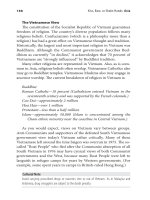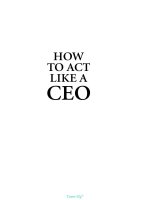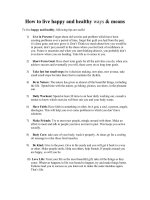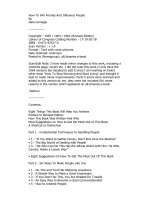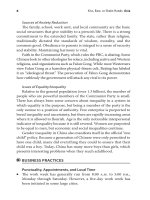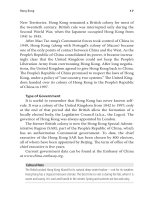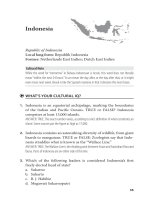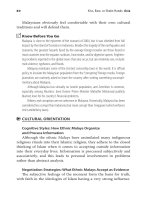how to act like a ceo 10 rules for getting to the top and staying there phần 4 pptx
Bạn đang xem bản rút gọn của tài liệu. Xem và tải ngay bản đầy đủ của tài liệu tại đây (120.99 KB, 22 trang )
“It’s fun to play around in the visionary role and not have to be
responsible. It really takes a marriage of vision and strategy and
tactics. Sometimes people are too caught up in the dream to see
tactics. Or too focused on what’s going to happen today and miss
the next day. The right mix minimizes confusion for everyone. You
need to go back and forth,” says Bruce Swinsky, President of
Kodak Imaging.
“You need vision plus action. Identify the target and the goal and
follow-through,” says Richard Gartrell, CFO of GoApply.com.
“And through the hurdles too. Most people who made big change
had ideas and had guts that carried them over the challenging times
which are pretty much all of the time.”
The great monkey wrench in everything is change
Change is necessary. And it will always be necessary, I guaran-
tee it. “When I stand up before my people and say ‘it’s tough now
but it’s going to be tough for a couple of years,’ I feel a lot of pres-
sure regarding all the change. Last night, I was driving home and
I was thinking about it and I found myself going 65 miles per hour
in a 30-mile per hour zone. There was a car slowing down in front
of me so I looked to my right and there was a tree; then I looked
to my left and there was another car. So I checked that my seat belt
was on and I hit the tree,” says Leo Kiely, CEO of Coors Brewing
Company.
Everything in this natural world goes through change.
To not constantly deal with change is to be foolish.
To be obstinate toward change is unproductive.
Change is a way to strive to perfect things.
HOW TO ACT LIKE A CEO
48
If things don’t change for the better, they will change for the
worse.
Change can be painful but it offers hope.
Don’t worry if your vision doesn’t work out for now. Nothing
works out like you thought anyway. The thing is to be flexible—
and change before it’s too late. You’ve got to be receptive to new cir-
cumstances. Besides, if your vision isn’t “on target,” you’ll end up
in the wrong place. So you might as well change while you still can.
Almost every CEO has told me one of the keys to success is know-
ing when to change and get out of a potentially bad situation.
Change doesn’t mean flitting from the latest fad to the latest fad
looking for some magic mantra.
Change is not all huge steps. Sometimes it’s little things.
Even relatively modest changes can be hard to accomplish.
— Ed Liddy
CEO, Allstate
“Today things are done in 4 to 1 time. Internet years are like dog
years. The rule is to do four things to everyone else’s one. Being
right can be just being faster. You always have to try to stay away
from the pack.” says Mike Moniz, CEO of VR.1.
“CEOs often are forced to make un-educated decisions based on
‘gut’ feelings and tidbits of rumored information. The e-CEO can-
not be firmly set in their opinions of process. What is valid today
will be completely outdated and invalid next week. Constant adap-
tation and acceptance of change is an essential quality,” says Brian
McCune, Managing Partner of e-merging Technologies Group.
It’s a fantasy if you think, for even a minute, that tomorrow will
come to you in a tidy predictable manner. To see around corners is
SEE AROUND CORNERS
49
to sense the changes happening around you and relate those changes
to your own and your company goals.
To enhance your own tolerance of change and even welcome it:
See change happening quickly.
Don’t relax about it.
See cause-and-effect relationships.
See how it all affects your business.
Then:
Plan for the unexpected.
Reduce complex situations to something simpler.
Come up with some ideas to deal with things, for now.
Tell people what’s going to happen, when, and why. Give signs.
Be the change maker so others have to react to it versus you
having to react. (Practically put—eliminate your stuff before
someone else does.)
Accept the fact:
Few people like to change involuntarily.
The price of change is leaving behind what you were comfortable
with.
You have to take hold of some things and let others go.
You have to change from “what am I comfortable doing?” to
“what can I achieve?”
And, finally, remember, change is eternal.
Embrace change that you see as inevitable. Don’t be afraid or
even hesitate. It’s like professional bicycle racer, Mike Emanuele,
HOW TO ACT LIKE A CEO
50
says about fear, “If you fear crashing you’ll ride timid and likely
crash anyway.” If you fear change, you’ll likely crash so “jump out
there where the limb cracks just to see how it feels to fall,” as one
CEO put it.
“You will have to break out of the comfort zone,” says Alex
Mandl, CEO of Teligent. “You have to have the stamina and courage
with almost fool-hearted confidence for a pioneering approach.”
Educated nerve succeeds when dealing with change. You don’t
know what you’ll get away with until you try.
And really, change is not a bad thing. Think about the technology
that made your last surgery easier and resulted in a faster recovery
for you. Think about the gadgets in your new car that make the trip
safer and more pleasant. That’s all due to change. If you really
thought about how much better our lives have become because of
change, you’d get down on your knees and ask God for more!
Most of us change out of necessity. Our desired goal isn’t going
to happen as a result of frustration or proactive decision; we have
to change. It might just be the gut feeling that things aren’t going
to go right. If you sense it, but don’t for sure know why, it isn’t
going to go right. Trust me. Change.
If the energy consumed to ward off the future from happening
were channeled into embracing it and being the change maker
everyone else has to react to, you might view it a whole lot differ-
ently. Maybe even like the Fireman Funds advertisement:
Life is a rush into the unknown. You can duck down and hope
nothing hits you, or stand up tall as you can, show your
teeth, and say dish it up baby, and don’t be stingy with the
jalapenos.
SEE AROUND CORNERS
51
TEAMFLY
Team-Fly
®
This page intentionally left blank.
CHAPTER 3
MAKE DUST OR
EAT DUST
Strategic thinking.
Decision making.
Planning.
Man plans. God laughs.
Old Jewish saying.
Everyone has a plan until they get hit.
Mike Tyson, boxer
Strategic planning can be an enigma. It’s a bit mystifying and it’s prob-
ably the most challenging part of the CEO’s ongoing responsibility.
Put very simply, strategic planning is looking, say, 3 to 5 years
down the road, seeing what will be needed in all aspects of
running the company, coming up with predictions to protect the com-
pany from undue risk, and then planning the corresponding tactics.
Of course, that’s 5 years if you’re a major company. For medium-
sized companies, the horizon might be 1 year. For small companies,
the horizon might be 30 days.
53
Copyright 2001 Debra A. Benton. Click Here for Terms of Use
Meg Whitman, CEO of e-Bay says, “We reinvent ourselves every
six months.” Many “dot com” companies do it every 10 days! And
one company CEO says he does it every day. (On the other end of
the spectrum, you have the Japanese Internet CEO, Masayoshi Son,
who has a 300-year—yes, 300-year plan.)
“Strategic planning is taking the major initiatives you need to put
in place so you’ll know where you’re going to be at some point in
time. That information then goes into the operating plan and that
then goes into the individual executive’s goals and objectives,” says
Bud Bilanich, CEO of The Organizational Effecgiveness Group.
“It’s was so well planned that I could always note the page and para-
graph in the plan that my personal goals were tied to.”
Regardless of your size or type of business, “Prior proper plan-
ning prevents piss poor performance,” as one CEO put it.
Of course, there’s the other expression, “plan your work and
never work your plan.”
Some CEOs say that strategic planning is an overused term,
“something to keep you busy while waiting for reality to happen,”
that “90 percent of the strategic planning done is a waste of time,”
“the plan is really good at only one point in time” (meaning the mo-
ment it’s finished), “seat of the pants is usually better,” and “it’s just
an excuse for the company to pay for the team to get a couple of
days at a golf resort.” Now they didn’t necessarily want to be quoted
on those statements though!
Important business success is about creating the future
instead of reacting to it. If you’re reactive, you’re already
number two.
— Stuart Blinder
CEO, ITOCHU International
HOW TO ACT LIKE A CEO
54
Good strategic planning provides:
Direction with great clarity for now and into the future.
Focus, thus avoiding the frustrating nonfocus.
A point from which to make change; a “gut check” from which
you can make course corrections.
A longer-term view of things so people have a sense of where
they are going.
An opportunity to get to “the future.”
And, the potential of moving fast enough on the right issues
with the right people. (If you take too long or trust the wrong
people, all the planning will be for naught.)
To plan, you have to “decide” on things. Strategic planning
evolves all around the CEO’s decisions.
CEO DECISION MAKING
Strategic (and tactical) planning, as much as any of the CEO’s actions,
takes effective decision making. This is where you make dust or eat dust.
As the CEO, sometimes you know everything you can know.
Sometimes you know only some, but not everything. And some-
times you know absolutely nothing—but you still have to decide.
The CEO is the drive and the ultimate decision maker who makes
up the gap between “rhetoric and resolution.”
“They say it’s lonely at the top. What that really means is that it
becomes so much more apparent that the decisions you make have
an absolute bearing on whether the company will become a future
winner or a loser. The more highly dynamic the market the more
there is only one person who gets to drive and that’s the CEO,” says
Bill Coleman, CEO of BEA Systems.
MAKE DUST OR EAT DUST
55
“I was the mayor of New York City for 12 years. I had a $28 bil-
lion budget. Each decision I made affected seven and a half million
people. The stakes were high. I had to show confidence—in partic-
ular, confidence in my decision-making ability—because a lot of
people had put their trust in me,” says Ed Koch.
The CEO lives or gets fired based on the validity of his
decisions.
— Dave Powelson
CEO, TRI-R Systems, Inc.
CEO decision making adds to that 1000 percent increased
effectiveness. You have to:
Assign priorities. All of the things that need to be decided on
are not equal in importance. Like you do with time manage-
ment, where you prioritize, rank the importance of the decisions
you have to make. It’s sort of like how one CEO described
about putting his effort in the wrong direction, “you get to the
top of the ladder and find the ladder was leaning against the
wrong wall.” Do not wobble or delay too long on committing to
a direction. (No direction is a decision in itself—a decision to
drift or relax and not move.) At least by setting priorities, you’ll
be going in a direction. If turns out to be the wrong direction,
you can make a course correction.
Set a time frame. There’s a difference of opinion here from
CEOs. Some say fast, not rushed, but fast is the way to go.
First, to keep up with the fast-changing times and, second, if
you do make a mistake, you have time to redo it. “Despite all
the formulas, decision making boils down to the gut thing. And
faster is better. Be 80 percent right and first rather then 100 per-
cent correct and last,” says Carol Ballock, Managing Director
HOW TO ACT LIKE A CEO
56
Burson-Marsteller/Corporate Practice. Of course, fast can be
relative: “I postpone a decision until I wake up one morning
and know where my gut is going,” says Deborah Triant, CEO of
Check Point Software Technologies. The other thought is that
slower (than you’d like) and methodical is the way to go.
“Every time I take it slow and analyze the situation I generally
come out better,” says Robert Buhler, president and CEO of
Open Pantry Food Marts. “It’s easy and macho to do it fast,
but it builds credibility when people feel you’re thoughtful
and reserved.”
Gather and review up-to-date cold, hard facts. Collect as many
facts as possible, but not too many. Organize them. “You can
wait and wait until it’s perfect and you have all information
possible, or you just have to go with your judgment,” says
Ed Liddy, CEO of Allstate.
Paint a scenario of the desired outcome. What do you ideally
want? If you haven’t thought about it, how will you know if you
get it?
Weigh plusses and minuses to getting there. There will be trade-
offs and compromises. Weigh the costs and the effects.
Explore the ramifications of all involved. Who will be affected?
“The CEO has to understand the impact decisions have on his
people all the way back through the supply chain. ‘Wear bifo-
cals’ so you see the close-up and the long-distance,” says Bill
Toler, President of Campbell Sales Company.
Go by the law, naturally! A surprising number of people in or-
ganizations do not concern themselves with this!
Keep human emotion out of it. As much as possible, anyway.
MAKE DUST OR EAT DUST
57
Use your inner wisdom, have courage, go with your gut instinct,
and decide. General Colin Powell uses the formula P = 40 to
70, where P stands for the probability of success and the num-
bers indicate the percentage of information required. “Once the
information is in the 40 to 70 range, go with your gut,” says
Powell. “Don’t take action if you have only enough information
to give you less than a 40 percent chance of being right, but
don’t wait until you have enough facts to be 100 percent sure,
because by then it is almost always too late. Today, excessive
delays in the name of information-gathering breeds ‘analysis
paralysis.’ Procrastination in the name of reducing risk actually
increases risk.” If the analytical approach ends up different
from your instinct, you really should stop and take the time to
figure out why the difference exists. You’ll probably end up
going with instinct but at least the analytical approach was
considered.
But don’t broadcast your decision just yet. If you, the CEO,
make the decision public, you become its “sponsor,” which can
skew the support from the beginning. Better to have someone
else come up with (the answer you wanted anyway) and let
them “own it,” sponsor it, and sell it.
Now, here, it does depend on the type of decision it is. How to
execute some part of the strategic plan can be decided by the person
implementing the plan, whereas in a crisis situation, everyone is
looking to the CEO to decide.
With a decisive frame of mind, go for your strategic plan. But
first: accept the fact that there are no “right” answers or directions.
There is an enormous amount of information that you have to sort
through to make the best possible decision. That takes a lot of work.
Then you cross your fingers that some “luck” gets thrown in.
HOW TO ACT LIKE A CEO
58
THE PHASES OF PLANNING
There are 47 different ways to do strategic planning; what I’m lay-
ing out is one proven way that takes you through the “planning” as
well as the ongoing strategic “thinking” needed in today’s fast-
changing economy. This approach can pretty much apply to all parts
of professional and personal life.
Strategic planning is giving direction to people you serve.
People need to know that there is a marriage of strategy and
tactics. It makes them feel good about the company and
where it’s taking them. But good leaders simplify.
— Bruce Swinsky
President of Kodak Imaging
In phase I of strategic planning bring in a bunch of outside ex-
perts on the future state of the world. Get different ages and differ-
ent backgrounds if possible. Have them tell you everything they
know as it applies to your business. Ask: where is the world going
(for example, technology, regulatory policy, world events, natural
events)? What are the trends and opportunities in the business
world? What opportunities fit your skills and resources? (This is
exactly what you did during the vision stage of talking to experts
and otherwise reading, thinking, checking on your thinking, chang-
ing, and going forward.)
Peter Drucker says the goal of planning is to understand what might
happen that would put you out of business and plan around that. So
get the experts to tell you what might happen to cause that situation.
The “experts” might be some of your mentors. They could be
paid experts. Or they could be your competitors. (The latter may not
be as receptive to providing much information but you can learn it
at industry meetings, through trade journals, etc.) The goal is for
fresh thinking outside of your company.
MAKE DUST OR EAT DUST
59
With the ideas you get, plan the strategic planning session.
Those who are involved are assigned to come up with the top
five or six most important issues in their areas and bring them to
the meeting.
In phase II, go offsite, even if it’s just across the street. Turn off
the phones; put you feet up on the table. Get away from the tactical
for now; go for lofty at this point. Get in a room with a white board,
with knowledgeable people from your company, and have free-
range thinking on everything you ever wanted to do better. Discuss
issues, with the goal being to end up with the top five or six issues
for the company.
The CEO is the driver of the strategic plan but he definitely is not
solely responsible for coming up with it. He must lead an intense
collaborative effort in strategic planning both from the top down
and the bottom up.
The “top of the house” gets together and weighs how to manage,
protect, and take care of resources. “We ponder the possible sce-
narios or problems that our company may encounter to reduce as
much risk as possible,” says Glenn McCall II, CEO of Global Ven-
ture Associates (and WildChild Enterprises).
The people in the trenches take the important issues and apply
them to the real situation in which the company is operating. This
level knows “what’s happening” because they are closest to the dif-
ferent customers, different markets, different times, and different
things going on in general. In the past you took the 5-year plan to
the ranks; now they bring it to you.
With the key issues you can break into small groups consisting of
people from all levels of the company. The “mix” in the teams en-
sures realism because they are the ones meeting with customers,
testing assumptions, and exposing their thinking to other con-
HOW TO ACT LIKE A CEO
60
stituents. You’ll get a lot better buy-in when you get to execution if
you’ve included them in the planning.
The first-line people on up need to be encouraged to refute any
ideas sent out from the top.
Set direction and scope. The “mission, objectives, goals, re-
sources” can be the outline of the day.
Discuss strengths and weaknesses of the whole not just the
parts. Ask “What strengths will we need? How do we shore up
our weaknesses?” These questions re-establish your core com-
petency so you plan around it. “We’re not in the soup business.
We’re in the simple meal business. That’s a broader perspective.
It’s like Black and Decker isn’t in the drill business but in the
making holes business. With that understanding of their core
competency lasers can become part of their broader perspec-
tive,” says Bill Toler, President of Campbell Sales Company.
Discuss where you are vulnerable. What are the threats and op-
portunities? Like Peter Drucker writes, “what will put you out
of business?”
Rethink the future customer. Ask: Where are they headed? Who
is the real competition? Now? Tomorrow? What competitive
strengths do we have? Again, the front line on up should get to
know the customer very well. Don’t let this be “lip service.” Re-
ally answer each one of these questions.
Isolate the various areas. There are various areas you can influ-
ence to “move your business,” depending on your business: prod-
uct development, geography, culture, technology, production,
facilities, distribution, real estate, advertising, promotion, public-
ity, investments, funding, marketing, and on and on. Here’s where
you discuss what participants brought in as their top five issues.
MAKE DUST OR EAT DUST
61
TEAMFLY
Team-Fly
®
Consider issues as it relates to what the customer wants.
Plan your strategic end game. Have a clear goal of where you’re
headed, how to get there, why and how you’ll do it in both a
practical and inspirational format. Sum it up so everyone “gets it.”
We have a traditional plan and a bungee plan.
— Brian McCune
Managing Partners of e-merging technologies
The good about the practical approach is that it is doable and re-
alistic, not just theoretical. “A strategic plan cannot create numbers
that cannot be duplicated in real life,” says Peter Mannetti, CEO of
US West Wireless. “Your plan can state ‘get to a billion dollars next
year’ but it’s impractical because you can’t hire 1000 people.”
If it’s just practical, you’ll likely underachieve your goals. Aspirational
plans go more for the “brass ring.” Consider if you had all the resources
in the world (think “pie in the sky”). What would you do? Go to the edge
and then trim it back to center in brainstorming the possibilities.
All of these steps could be done by the CEO, or with his execu-
tive team, but including the people who end up doing the work and
are also closest to the customer will make it ultimately more suc-
cessful. The operators feel they “own it” and are “not stuck with it”
when they are involved. Plus the CEO avoids the proclamation from
the front-line people frequently heard in corporate America, “If
those guys (that is, the executive circle) got any dumber!”
When you do finally decide, remember the “buck stops here”—
with the CEO—regardless of where the idea originated. You sought
their involvement but now you’re responsible for the outcome.
Lots of sharing of knowledge and responsibility but the CEO
ends up with responsibility of final direction.
— Jim Perrella
CEO, Ingersoll-Rand
HOW TO ACT LIKE A CEO
62
In phase III execute the plan. Lay out the path you will take.
Using all the convoluted thinking, talking, redefining, and “volu-
minous cascading plans,” now’s the time to turn your brilliant ideas
into a fantastic, simple, succinct operating direction.
The “direction” must be something all conversations can include
in its context. It must help people ground and translate complex sys-
tems and theories. It must ring true for general managers and truck-
ers. And it must be relevant and ongoing.
“Any plan you do and leave on the shelf is an exercise, not a
plan,” says Paul Schlossberg, CEO of D/FW Consulting. “It should
be short and be referred back to all the time.”
It’s important to remember that a plan doesn’t make reaching ob-
jectives a lot easier but a little easier. In the real world it’s like Bill
Coleman, CEO of BEA Systems, says, “The CEO has to put the
system in place and steer during the tornado.”
Years ago, Gillette had a 5-year strategic plan to consolidate the
European marketplace. While their executives were busily execut-
ing the plan, the Berlin Wall came down. One of the biggest events
in modern history and Gillette was totally unprepared for it. So they
missed the opportunity to expand into the Eastern block companies.
“Don’t get so fixated on a strategic plan so you miss opportuni-
ties along the way,” says Jack O’Brien, CEO of Allmerica Financial.
Again, first-line involvement helps the top line stay close to the ac-
tion.
To execute:
Work to convert your strategic intent into meaningful work
objectives and plans.
Set specific targets and target dates.
Corroborate your policies with your strategic intent.
MAKE DUST OR EAT DUST
63
Allocate resources you’re going to need to meet your
objectives.
Staff the organization to meet your strategic intent.
Clear accountability.
Set milestones to check if you’re getting where you want to go.
Allow time for the unexpected. Plan for “desperate moves.”
Repeatedly prioritize, focus, and simplify.
Come up with new processes for formulation, implementation,
and assessment of plan phases as needed.
Reinforce goals at every step.
When something goes wrong, it’s back to phase I. It’s a process
that keeps repeating itself. When you get lost, go back to your plan.
(Authors Note: The preceding information was garnered from
several interviews with various CEOs. And it should serve you well
for solid strategic direction.)
Since this subject is so important, I wanted to provide a very de-
tailed step-by-step approach taught at Vanderbilt University. Fred-
erick Glossen, CEO of MB Industries, attended the program and
shared the takeaway he had from it.
“I use the following outline to develop our strategic plan,” says
Glossen. “I’ve found that by forcing ourselves to go through this
process, even at the moments you feel you can least afford the time
or resources for something that doesn’t yield a direct result, it is
most needed. This process has a tendency to bring order to chaos,
which tends to be the culture of most startups.”
1. Prework one:
a. Departmental/functional area input
i. Staff-level input on SWOTs (strengths weeknesses op-
portunities threats) and priority issues
HOW TO ACT LIKE A CEO
64
b. Top team preparation: Individual
i. Assess strengths, weaknesses, opportunities, threats,
priority issues, programs, and key result areas
c. Top team preparation: Assigned and circulated
i. Environmental analysis
ii. Market and competitive analysis
iii. Financial: history and forecast
iv. Strategic and organizational diagnoses
2. Priority-setting meeting:
a. Discussion
i. Environmental analysis
ii. Market and competitive analysis
iii. Financial: history and forecast
iv. Strategic and organizational diagnoses
b. Consensus
i. Strengths, weaknesses, opportunities, and threats
ii. Priority issues
iii. Strategic programs
iv. Key result areas
v. Assignments for planning meeting
vi. Core strategies
3. Prework two:
a. Individual
i. Programs to address priority issues
b. Assigned/circulated:
i. Draft direction statement
ii. Draft objectives
iii. Draft overall strategy statement
iv. Balance resources
MAKE DUST OR EAT DUST
65
4. Strategic-planning meeting:
a. Consensus on:
i. Direction statement
ii. Objectives
iii. Strategy
iv. Key programs/action plans
v. Resource allocation
vi Communications
vii. Review structure
5. Postmeeting work:
a. Completion of action plans
b. Coordination of programs
c. Delegation of objectives/steps
d. Final strategic plan
“To get the most out of your personnel I have found that you need to
give them tools to extract the information,” says Frederick Glossen,
Jr. This can typically be done with the following questions.
Where are we now?
Situation analysis:
What trends in the external environment, particularly in the
marketplace, can help (opportunities) or hurt us (threats)?
What markets should we focus on? What should our strategy
be in each?
What are our internal strengths and weaknesses?
What are our core competencies that can be leveraged to beat
competition, meet our customers’ needs, and ensure our future?
HOW TO ACT LIKE A CEO
66
Taking our SWOTs into account, what are our priority strategic
issues–those issues that must be resolved if we are to have an
excellent future?
Where do we want to be?
Strategic direction:
What is our fundamental purpose in life? Why do we exist?
What is our vision for the future? What do we want to become?
How do we define the scope of our future business, including
markets, products, and services?
What values will guide our actions toward our internal and
external stakeholders?
What are our objectives?
What are the key areas in which we must get measurable
results if we are to fulfill our vision?
What are our specific objectives in these areas? When will
we be able to measure results in each?
How we get there?
Strategies:
What are our strategic alternatives—different ways we could
structure, run, or dispose of the business?
What are our selected “grand strategies” for the business,
including growth posture and means of change such as internal
growth or acquisitions?
What are our external operations strategies—those things we
will do to sustain a competitive advantage?
MAKE DUST OR EAT DUST
67
What are our key internal strategies—those actions, investments,
and processes critical to sustaining our external advantage?
What are the handful of priority issues, or programs that will
help us to implement our strategies?
Who must do what?
Delegated objectives and action plans:
Have objectives and priority issue programs been delegated to
the departments, teams, and people who must implement them?
Have measurable and realistic action plans been developed to
meet these objectives?
Have we ensured that the plans and actions of key leverage
individuals and departments are aligned with the corporate
direction?
How are we doing?
Reviews:
Do we have an effective top-team mechanism to review
program action plans and progress toward objectives?
Do we have a mechanism to ensure that lower-level plans,
important to corporate strategy, are reviewed?
Are individuals and teams held accountable for their plan
results and rewarded or not rewarded accordingly?
What is important to recognize is that the plan is not static. Once the
plan is in place, it is not intended to be put on the shelf and forgot-
ten. Rather, the plan should be a living and breathing document that
is reviewed quarterly (Quarterly Strategic Review Meetings and
Quarterly Performance Reviews).
HOW TO ACT LIKE A CEO
68
“The strategic planning process as we use it is to step outside the
company and navigate it through the pitfalls if it is ever to realize it’s
potential…. It forces not only the CEO but also allows a forum to
get buy in from the rest of the organization to shape and form the
company,” says Frederick Glossen, Jr., CEO of MB Industries.
WHEN THINGS DON’T GO
ACCORDING TO PLAN…
“When it comes to the endless hours of strategic planning necessary
in order to effectively compete in today’s environment, there is still
no guarantee as to what the collective outcome of these decisions
will be,” says Kyle Kundivich, Chief Strategist of Global Venture
Associates.
“When plans go awry I first look at the plan’s ‘life-line’ to es-
tablish exactly what milestones have already been covered, what are
the new determinants and assumptions. Does the failure of this
plan, at this stage, greatly affect the corporation or does it simply
point to a new opportunity? And second, I ask how critical is the
remainder of this plan to the company’s longer-term growth and
global scale? The important thing here is to avoid panic and to keep
worry at bay. This is even more significant when you are the one
that others will be looking to for guidance and motivation. I have
found that panic can cloud judgment and worry stifle creativity, two
of the major tools needed to overcome most obstacles,” says Chris-
tian Boucaud, Country Manager–Brazil of S.M.J. Beverages.
Each planning misfortune is quickly analyzed to ascertain the
major reasons for its incompletion. I ask:
Was it due to economic changes that were outside of our
immediate control?
Was it due to wrong assumptions made at the very beginning?
MAKE DUST OR EAT DUST
69
